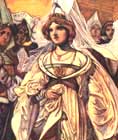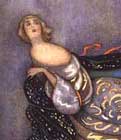
Cinderella:
345 Variants
by Marian
Roalfe Cox
SurLaLune's
Cinderella Area
SurLaLune Fairy Tales Main Page
284
Grundtvig, S., Gamle danske Minder i Folkemunde. Copenhagen, 1857. II. 157. (From Vendsyssel, a district in Jutland. Narrated by a field labourer.)
"PRINSESSEN PA OEN"
(The Princess on the Island).
ABSTRACT
English prince woos Danish princess; may not have her. War ensues. Danish king walls up heroine with seven maidens on island with provisions for seven years. King slain; heroine for gotten. Maidens in turn all killed and eaten. heroine eats dog and cat, then mice, hanging mouse-skins on strings. Gets out of castle; signals to ship; is rescued and landed at capital--Menial heroine (scullery-maid at father's palace)--New king will wed anyone who can finish web (heroine's)--Duke's daughter tries; heroine finishes web for her. Bride, afraid to ride heroine's horse to church, bribes heroine to go in her stead; cannot presently repeat to bridegroom things said on way to church, nor return his gold gloves; brings heroine into darkened room to restore gloves. Prince holds her fast--Happy marriage.
TABULATION
(1) King of England has a son, who, seeing picture of Danish princess, falls in love with her. Father approves his choice, saying, "When Denmark and England agree, no power on earth can master them." King of Denmark will not give up his daughter, and war between the kings ensues.-- (2) Prince enters Danish capital; the king sends his daughter to a distant island, with seven maids, a little dog, and victuals for seven years. Here she is strictly immured in a castle. Danish king falls in battle; the capital is taken by English prince, who walks through all the rooms in the castle.-- (3) In one he finds an ebony loom bearing an unfinished web, into which are woven birds, fishes, and all kinds of beasts. Having vainly sought everywhere for the Danish princess, he proclaims that whosoever can finish the web shall be his bride. A certain duke has a very clever daughter who tries, but in vain, to finish the web; it is too cunningly wrought.-- (4) In the meantime heroine and her maids, having consumed the victuals, try to break their way out of castle. One of the maids proposes that the rest should kill and eat her, as she cares not to live; and so in turn do all the seven. Only heroine is left, and when she has eaten the dog she catches mice for food, and hangs their skins on strings. At length she gets out, signals to a distant ship by waving a blanket, is taken on board and brought to father's country.-(5) Here she doffs her rank dresses and, clad in rags, seeks employment as scullery-maid at the castle. She sometimes has to carry water for washing into the room where the loom is. Duke's daughter tells her she never knew such a difficult piece of work. Heroine says she believes she could finish it, and is allowed to try. She begins by remaking the whole, and, after a few days, duke's daughter tends word to prince that the web is finished. Though doubting her truthfulness, he is obliged to marry her.-- (6) Heroine's horse Blanke has grown wild and unmanageable during the seven years. The bride is to ride it to church. Duke's daughter is afraid, and offers heroine too dollars to wear bridal dress and go to church in her stead. So it happens. Crossing the bridge, heroine says:
"Bridge, do not crack or break with me,
The king, my father, builded thee."
And to the dog:
"Nay, you should not bark at me,
Tire king, my father, petted thee."
Mounting the walls, she says:
"Swimming 'neath these walls of green
Lovely fishes may be seen.
As naught could be had for my red gold, my dower,
The seven maids and the dog I was forced to devour."
Prince asks what she said. "Nothing at all." She sees in the distance the island where she had been immured, and says:
"See hanging there the mouse-skins grey
Which these small hands of mine did flay;
If hunger did not drive me to it,
Far rather would I die than do it."
Same question from prince; same reply. They go up to the horse. It is restive, and kicks. Heroine says:
"Bow to me, Blanke, my steed,
The last maid that rode thee
Was I indeed."
Instantly the horse kneels down. The prince discovers who the lady is who rides beside him. At the church he pulls off his gold gloves and gives them to heroine, she must swear to return them to him and to none other. Then they are married and return home.-- (7) Heroine and duke's daughter exchange dresses again. Bride has to ask chambermaid for the words she must repeat to prince, who at last demands the gloves. Heroine will not give them up, but consents to go into bedchamber, where the light is put out.-- (8) She puts out her hand and prince holds her fast, and dismisses duke's daughter and sends her home. Prince marries heroine.1
NOTES
Note 31
(P. 231.) Among Prof. S. Grundtvig's Unpublished Collections are extracts of four vaniants of the foregoing stories. In the first, which is called "Rosenrod", the queen's nose bleeds, the drops falling in the snow. She bears a daughter, who is named Rosenröd Snehvid (Rose-red Snow-white), who is shut up in a tower with her attendants for seven years. Only the princess lives to come out with her little dog, and she becomes a servant in new king's castle. She takes bride's place at wedding--the horse Buckbar--the mouse-skins--the wedding ring--the mysterious words, etc. The remaining three variants differ in no respect from those already given.
The following legend is from J. M. Thiele's Danmark's Folkesagn (1843), i, p. 8:--
"THE TOMB OF THE THREE MAIDENS."
A king in the Danish island of Fyen has three fair daughters engaged to three princes, who are absent taking part in the war. Three giants present themselves and woo the princesses, offering gold, silver, and costly rings. The princesses are faithful to their lovers, and the giants go away in a rage, threatening to return soon. King has a large mound with a chamber inside it made for his daughters, and the place is covered over with trees and shrubs. The giants return, slay the king, and at length discover the hiding-place of the princesses, through the barking of their little dog. When they find that the giants are digging them out, first the youngest and then the other two princesses stab themselves to death. To this day the hill is shown. The giants are still said to pass over it with noise and fury; horns are sounded, and the barking of the dog is heard from within the mound.
Cf. Saxo. Grammaticus, lib. vii, for the history of Sigvald or Sivald. Regnold conceals his daughter Gyritha in an underground chamber, whence she is dug out by Gunnerus.
See Nos. 276, 283,
(284), 289, 290,
291, 292, 293,
(294), 299, 302,
303.
Return to place in text.
Cox, Marian Roalfe. Cinderella: Three Hundred and Forty-five Variants of Cinderella, Catskin, and Cap O' Rushes, abstracted and tabulated. London: David Nutt for the Folklore Society, 1893.
While the original text of this book is out of copyright, the special formatting and compilation available on SurLaLune Fairy Tales is copyrighted. Be aware that while the original content has been honored, page numbering, footnote numbering, redesigned charts, links, and other aspects are unique to this site's version of the text. Use at your own risk. For private and fair use educational purposes only.
©Heidi
Anne Heiner, SurLaLune Fairy Tales
E-mail: surlalune@aol.com
Page last updated February 1, 2006
www.surlalunefairytales.com










